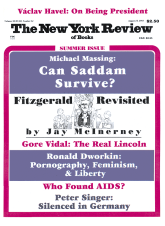James J. Angleton was installed as chief of the Central Intelligence Agency’s Counterintelligence Staff in 1954. He would run it for the next twenty years for a succession of agency directors whose original admiration for his judgment mounted to sustained awe of his omniscience and then plunged, by no means prematurely, into alarms for his sanity.
Angleton’s career has now been so illuminatingly studied by Tom Mangold in Cold Warrior as to make irresistible the inference that the aberrancies of his stewardship went unnoticed for at least twelve years before unsettling the CIA’s faith in his sovereign wisdom.
He had been the CIA’s major resource for assessing the intentions and the schemes of the Soviet Union’s espionage establishment, and he had almost unfailingly misread them all. It was the rule of his life to trust no one, and he seems to have broken it only twice. His first breach was trading security confidences with Harold (Kim) Philby, British intelligence’s liaison officer in Washington, and a Soviet spy.
Angleton next tendered the full faith and credence he withheld from all others to Anatoly Golitsyn, an early Soviet defector with the wit to pass himself off as a significant KGB figure. Mangold makes it clear that Golitsyn was something of a fraud and even more of a con man who cunningly eliminated all possibility of competition from any of the Soviet defectors who followed him by persuading Angleton that each was a KGB plant.
Golitsyin had made his sway over this addled head so complete that the Angleton who always had trouble telling the false from the real now commenced unvaryingly to mistake the one for the other.
Every apparent positive could only be understood as in fact a negative. The Chinese and the Soviets quarreled in public and substantial elements in the Czech Communist party broke with Moscow, and Angleton would gulp down Golitsyn’s explanation of any fresh evidence of internal communist crisis as but one more counterfeit piece of the Soviet disinformation campaign. The larger the influx of KGB defectors to the West, the surer Angleton grew that what common sense would take for the unraveling of the Soviet secret-service blanket was in reality a new proof that it was closer knit than ever.
But having never before been all that tightly woven himself, he was now unraveling all the way. Golitsyn’s contrived fantasies had become the credo of his own. A warning from Golitsyn of a KGB mole burrowing inside the CIA itself aroused Angleton to set his hounds to range through the agency, ruin the careers of several innocent parties, and damage the Soviet division almost beyond repair.
At last, having failed to find the mole anywhere else, Chief Investigator Clare Petty turned upon Angleton himself and produced a four-footdeep dossier establishing an “80–85 percent probability” that Angleton had been a Soviet agent all along. Petty’s study was the final triumph of the infective properties of his master’s paranoia and at once in perfect key with Angleton’s spirit and more plausible than most of its products.
Still the chances are that Angleton was an entirely honest fanatic and altogether sincere while disabling the CIA’s spy and counterspy operations as effectively as the KGB could hope.
Abundant as Mangold’s revelations are, it is hard to think they might matter. The little we know about the CIA since Angleton scarcely fortifies our confidence that the experience has made it any less vulnerable to penetration by fantasists.
To read about Angleton is to stir, as so often, with the melancholy thought of how small a difference history’s lessons make in what we do. We may, however, console ourselves with the thought that what we do makes little difference to history either; otherwise the Soviet Union wouldn’t have unraveled on its own initiative and with no need of the assistance the CIA might have provided if it hadn’t been lamed by James Angleton.
This Issue
August 15, 1991



